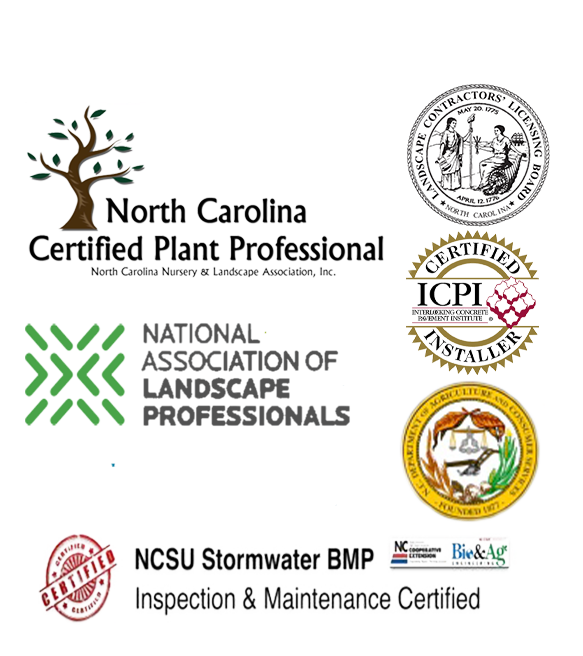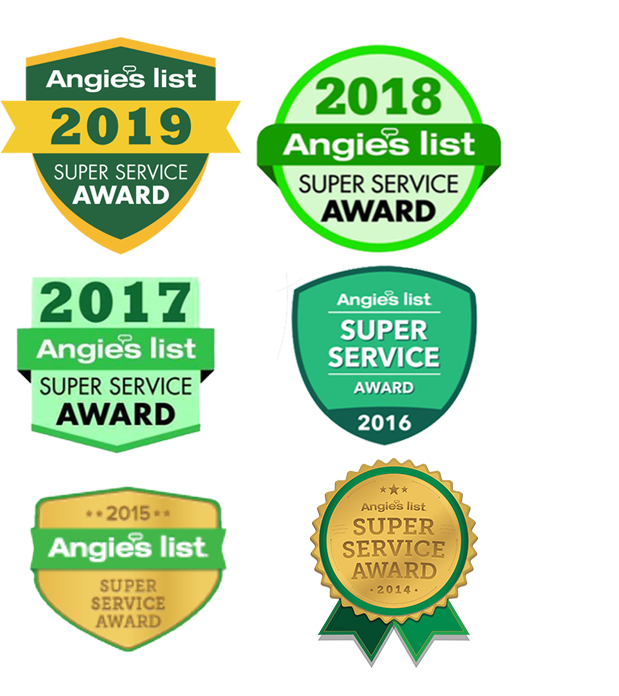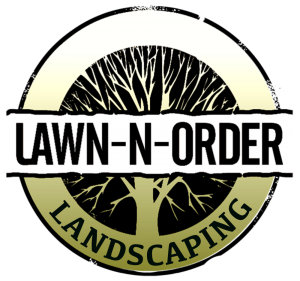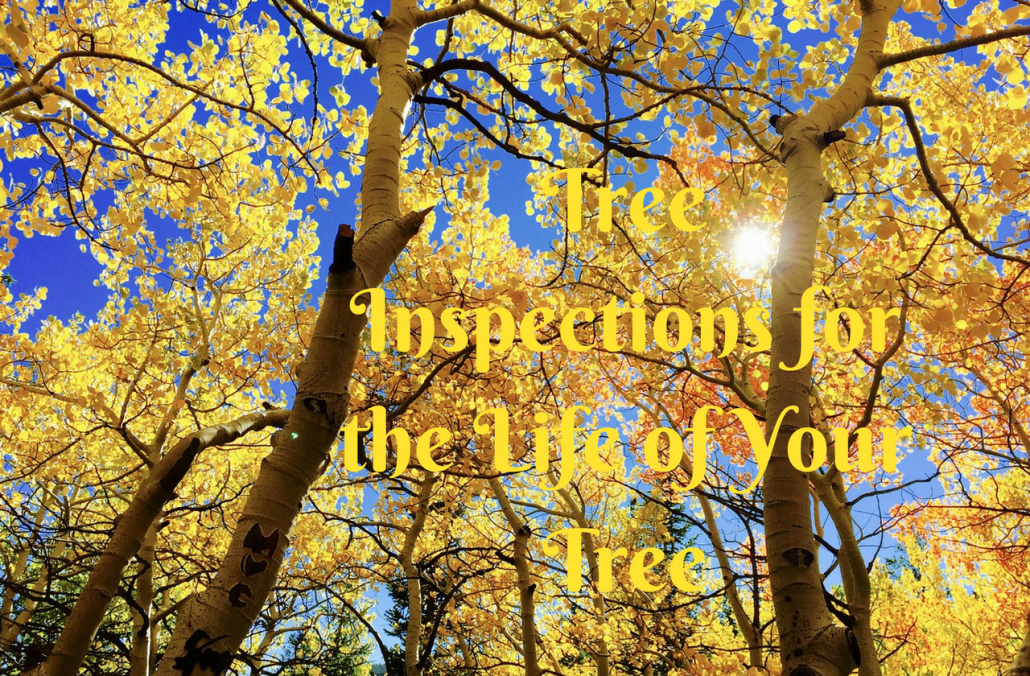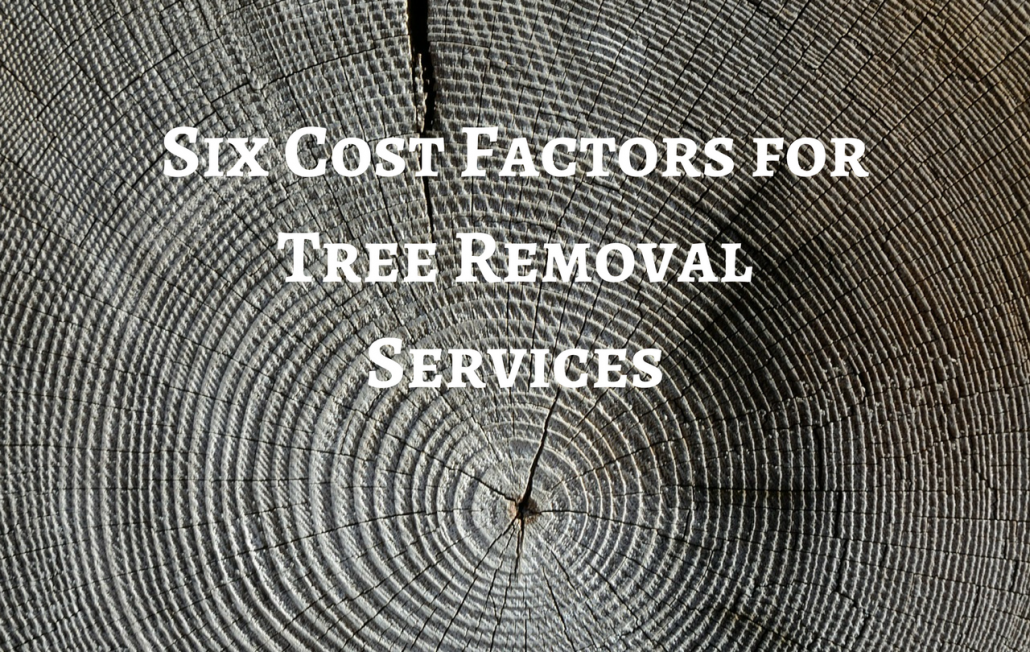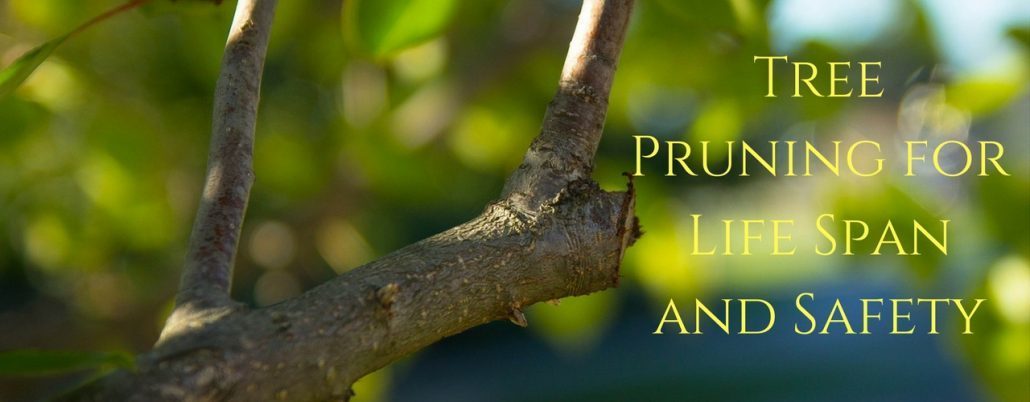Tree Inspections for the Life of Your Tree
/in Tree Health, Tree Services /by Lawn-N-OrderTree inspections are not something we think about annually like we do fertilizing our shrubs, but it should be a part of your annual maintenance. To keep trees healthy and growing vigorously we recommend tree inspections of the root zone, trunk, tree crown, and after storms. Make an inspection before planting a tree, to prevent health issues later.
Before Planting
Locate where your septic systems, drain fields, and underground drainage pipes are at. Plant far enough away to not hamper or destroy the underground systems. Look at the height of electrical lines before placing a tree under one or close by. Consider the mature height of your tree and allow the circumference width. Placing your tree close to clothes lines, play areas, bird feeders, satellite dishes and antennas or specialty lighting before it has reached mature height may warrant a removal or transplanting later. Allow for growth and plant accordingly. Lastly, be aware of your property lines and ensure that the mature growth will not encroach on the neighbor’s property.
Tree Inspections: After a Storm
High winds or heavy, wet snow will accumulate on the branches and wreak havoc on your tree branches. Branches and limbs can bend and break under heavy pressure or hang suspending by a few cross branches. These lodged limbs can be a hazard to a tree climber as well as the homeowner if not taken down properly. These tree inspections will ensure the falling limbs do not damage other parts of the tree. A tree climber can inspect for conditions that can’t be seen from the ground up. From the ground, a binocular inspection can help but up close can render more information.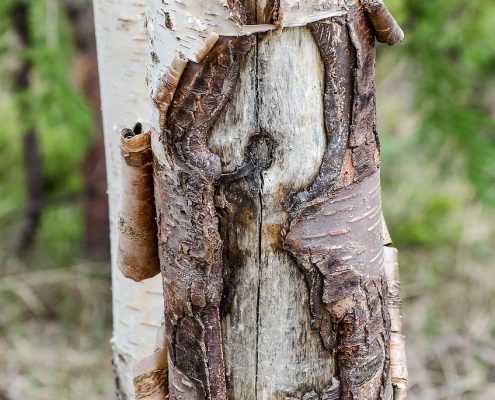
Tree Inspections: Tree Crowns
True ‘crown reduction’ techniques ensure the health of the tree is not endangered and that the budding limbs remain intact to bring in the sunlight. Many inexperienced contractors that have not had adequate training call it ‘round over’ which is a crude work term that causes more damage. When hiring contractors, make sure they abide by ANI A300 Pruning Standards. A tree climber will look for loose or dislodged, dead, damaged and diseased limbs and remove properly with correct pruning techniques as outlined in the ANI A300 Pruning Standards. We look for cracks and splits along stems and branches and at the cross sections where the branches are attached to the main trunk for pressure points. Burrowed animals within the trunks of the trees or cavities can indicate damage, disease, and rot. Close up inspections can reveal wood-boring insects eating away at the bark and the internal cavity.
Tree Inspections: Trunk
Some indications of rotting on the trunk of the tree will be noticeable with mushrooms present at the base. Remove invasive vine growth each year to give your tree breathing room and not competing for nutrients at the base of the tree. Loose bark can indicate a dying tree and the presence of bark beetles. Fungus on a trunk is also a sign of dying and decaying.
Tree Inspections: The Root Zone and Base
A proper anchoring of the roots will keep the tree healthy and vigorous. If absorption of nutrients through the root system is not available and other factors are present as indicated previously, the tree will suffer. Observe and inspect the root zone around the base. The root flare should be full and uninhibited by soil. Compaction around the base of a tree can happen over many years of time, rainfall, traffic, and 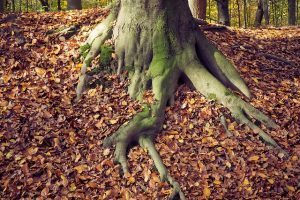 equipment. Ensuring the root base is free of obstacles will need to be observed. Removing water sprouts and suckers will be pruned from the interior and base of the tree to prevent them turning into larger limbs. These will suck the health away from the tree. This regular grooming to the main central trunk system is imperative.
equipment. Ensuring the root base is free of obstacles will need to be observed. Removing water sprouts and suckers will be pruned from the interior and base of the tree to prevent them turning into larger limbs. These will suck the health away from the tree. This regular grooming to the main central trunk system is imperative.
These are procedures that we put into our tree inspections to keep the life of your tree healthy and keeping you ‘in the shade’ for years to come. Give us a call for a consultation if you haven’t had a tree inspection in a while.
Tree Removal Services
/in Tree Health, Tree Services /by Lawn-N-Order“How much will it cost to take down my tree?” Many factors go into determining an estimate for tree removal services.
Five Cost Factors for Tree Removal Services
- “What are the dangers in felling?” We take a look at the area around the tree and if there is property or structures that are in the way when bringing the tree down. Will it need to be cut in smaller pieces or dropped to protect neighboring trees or property in the vicinity? Most taller trees have to be reached by a tree climber and there is considerable risk involved. A tree climber has to measure their steps and consider the integrity of the tree trunk and its branches as they climb. These considerations are a part of the estimated cost.
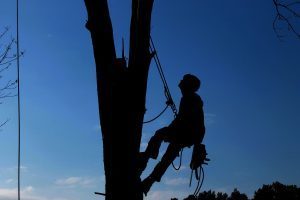
- “How is the ingress and egress of the property for removal?” Removing the tree will take room to cut the branches of the tree and haul it with a winch and drag loader to the chipper machine. A mini-excavator might be used to pick up the massive logs after being cut into truck size lengths to be hauled away. A chipper could be used to chip up the branches to be hauled or used as mulch on other parts of the property. Bucket trucks are often used for a climber to go up and cut off sections of branches and limbs or the main trunk. Cables will have to be harnessed around the tree and branches and brought down piece by piece. Bucket trucks are in the neighborhood of $80-120K, plus the risk associated with using them. This machinery will need a place for access and parking.
- “Is the tree close to a structure that has to be dismantled?” For instance, if the fence blocks access to the tree or where the tree will be taken out, will the fence need removing for a period. That can be labor intensive and add to the cost of the tree removal services.
- “What is the tree’s diameter and the age of the tree?” The diameter and height of the tree will also determine how high the tree climber will climb or what kind of lift could be involved to reach the top portions of the tree safely. The diameter will also determine cables to use and lowering secured portions down to the ground.
- “What is the structural integrity of the tree?” Is the tree branches or trunk rotted or sturdy? We look for several factors on the tree to determine this. A resistograph machine
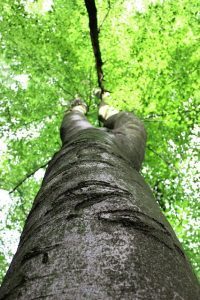
Two leaders are not better than one. This main trunk is separated with two leaders, which lessens the structural integrity.
can also be used to check the central cavity and give a report indicating any decay on the interior and at what depth. This reading provides an idea of the safety and health of the tree. Risk factors are part of the consideration for a tree climber which all go into determining the overall costs for tree removal services.
- “What will my yard look like after the tree removal?” If the tree is in a wooded area, there is not much of a problem with cleanup. If a tree is going to be taken down in a landscaped yard, there is a restoration process afterward. The removal of wood chips (for ground stumps), restoration of the lawn area because of heavy equipment and traffic can scare up and rut the lawn in areas. Aerating, sowing grass seed or laying new sod might be a possibility in the cost. If any landscape plant material is transplanted or removed before the tree removal, then those plants will be put back into their original spots or new plantings introduced. All of this cleanup will add to the cost of the total tree removal services.
If you are at the point that you need tree removal services or wondering how healthy your tree is, give us a call for a consultation. We will work with you on each of these factors and explain the ‘how and why’ behind our costs.
Tree Pruning for Life Span and Safety
/in Tree Health /by Lawn-N-OrderWhy Pruning is Necessary
Pruning a tree is required to maintain the life and health of the tree. The early years of a tree’s growth are crucial to its silhouette, vigor, and overall life duration. Trees are an asset to the landscape in many ways. Trees offer shade and lower utility bills. They can produce food and provide shelter for animals and birds. Keeping them in good health will give the homeowner years of protection and enjoyment and add value to the property. Sometimes a tree’s appearance can appear lopsided, and trimming can give it an overall better appearance. Crowded growth can inhibit air flow, hence being a recipe for disease. Branches that cross or rub against each other or another object such as a fence will create a wound. Damaged and diseased limbs should be cut out to lessen the spread of infection.
What to Prune and Not to Prune
When a tree is first planted, step back and look at the overall shape of the tree. Remove any broken branches that could have occurred in planting or moving. Remove competing leaders that will inevitably hamper the life span. Prune damaged or diseased limbs or branches at this point. Remove all tags and ties from the tree. Ensure the root system has plenty of room to grow and expand to anchor the tree and feed the branches. Remove oddly shaped branches for the overall look of the tree. Prune any branches that are rubbing together. Eliminate branches that are impairing a walking space or protruding in undesirable locations.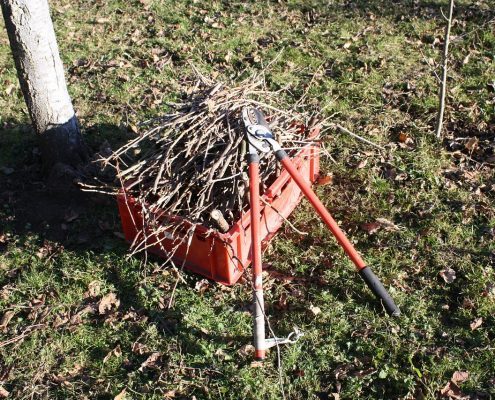
Inspecting Your Trees
Trees can come under stress for various reasons. Droughts, floods, heavy winds, heavy snowfall, can all take a toll on the branches and root system of trees. Using a set of binoculars to inspect your tree annually or after a storm can prevent damage later to your property or persons. Check for loose limbs that may have fallen and gotten caught in other branches. Look for tears in the bark or wounds that could be an entry for disease. Inspect the bark carefully for pests or holes. The ground around a tree can also contribute to the health. Is it compacted or recently been moved? Piling excess amounts of soil or mulch around a tree’s base can eventually strangle it from getting the necessary oxygen levels it needs to survive. Driving heavy vehicles or equipment over the surface near the tree roots will compact the soil and make it harder for penetration of water and nutrients. A newly installed driveway or sidewalk near the root system will affect the health of the tree. If the leaves are still on the trees, look for barren spots where leaves no longer grow and mark that branch to be removed at the proper time.
Variety of Trees to Prune Now
While trees are dormant in the winter and the sap is running low, it is an excellent opportunity to prune deciduous trees such as Chaste trees, crape myrtle, Smoke Tree, Maple, Walnut, Birch, and Oaks. Spring blooming trees such as Cherry’s should be pruned immediately after the flowers fade instead of prior. As a rule, prune trees that bloom in mid to late summer in dormancy during the winter months. Avoid pruning trees in the fall because the healing process of wounds take longer and make the tree more susceptible to fungi.
Pruning Shoots & Suckers off Trees
Some trees will offer up shoots and suckers to regenerate itself as the tree gets older to regenerate itself. Other times suckers are apparent because of some injury or disease to the tree to grow more branches to recover. Eliminate these shoots and suckers to prevent the diversion of water and nutrients away from the main trunk. Shoots will pop out are around cut wounds on a tree. Remove carefully in order not to cause more harm or to tear the bark of the tree. Suckers will grow at the base of a tree so remove by moving some of the soil to find the base of the sucker. Cut close to the base to Inhibit further unnecessary growth. Annual vigilance will keep your tree from regenerating in this way and help it to thrive. Trees that are likely to sucker include Angelica trees, Beech, Birches, Buckthorn, Apple trees,
Proper pruning and tree care will extend the lifespan and add strength to the branches against harsh weather conditions. An annual inspection and pruning will keep you in the shade for a long time. If you need tree work done, call us for a consultation today. 828.774.1590.
2014 Super Service Award from Angie’s List
/in Land and Lot Clearing, Landscape Contractor, Landscaping, Lawn care, News, Stonework, Tree Health /by Lawn-N-OrderLawn-N-Order Landscaping Earns Esteemed 2014 Angie’s List Super Service Award
Award reflects company’s consistently high level of customer service
Lawn-N-Order Landscaping, serving the Asheville and surrounding area has earned the service industry’s coveted Angie’s List Super Service Award, reflecting an exemplary year of service provided to members of the local services marketplace and consumer review site in 2014.
Ryan Houston: “We accomplished this award in seven categories by keeping our  services focused on quality, and by dealing with each property individually with focus on the end result. We work with each client one on one, to come to the end result, being a property transformation that they are happy to pay for. We do this by giving the customer a turnkey operation with attention to detail, and better than what was expected.”
services focused on quality, and by dealing with each property individually with focus on the end result. We work with each client one on one, to come to the end result, being a property transformation that they are happy to pay for. We do this by giving the customer a turnkey operation with attention to detail, and better than what was expected.”
Founded in 2000 as Houston Landscaping, Lawn-N-Order Landscaping gives low maintenance landscape solutions in Western North Carolina
The business originated in 2000 under the owner’s name “Houston’s Landscaping.” With some flyers and a borrowed weed-eater, Ryan Houston began his business on a song and a prayer. One job lead to another one and his American dream was born founded from his love and interest of the outdoors. In 2003 the business name was changed to Lawn-N-Order Landscaping. Since the businesses inception, LNO works locally as well as in surrounding states (Virginia, Tennessee, South Carolina, Florida) and the Cayman Islands. We are passionate about our service and love to maintain the artistic attributes of nature through landscaping. Education is part of our life long commitment to excellence in our field to develop, expand and educate ourselves on improved techniques and thus improving our service to clients. Experienced, uniformed and qualified team members perform all of our work with a job supervisor on each project site.
The owner, Ryan Houston will personally consult, plan, propose and oversee most of the larger jobs. He is a WNC native and has twenty-four years experience with WNC plants and wildlife. Ryan is an accredited NC Licensed Landscape Contractor certificate #1933, one of less than 2000 ever in the history of North Carolina with only approximately 1000 of who are still active. He is also a Certified Plant Professional as well as completing rigorous testing from the State of North Carolina to achieve this certification. Ryan Houston and staff are also NC State Certified in the knowledge and application of pesticide and herbicide application making them knowledgeable about plant pests and diseases. This contributes to his overall knowledge of how to plant hardy and low maintenance landscapes that will thrive in the mountains of WNC. He specializes in dealing with sloping properties and hillside problems such as erosion, water runoff, and planting on steep slopes. Ryan and his crewmembers were awarded the ICPI Certification. They participated in two days of extensive training and review on interlocking concrete pavers. Lawn-N-Order holds the title of “ICPI Certified Installer’ and has met all the nationally recognized guidelines for interlocking concrete pavement installations. With Ryan’s client testimonials, you will see that he has excellently handled large projects and has several long-term fans for his rewards.
“Only about 5 percent of the landscape companies in Asheville/Buncombe County have performed so consistently well enough to earn our Super Service Award,” said Angie’s List Founder Angie Hicks. “It’s a really high standard.”
Angie’s List Super Service Award 2014 winners have met strict eligibility requirements, which include an “A” rating in overall grade, recent grade, and review period grade; the company must be in good standing with Angie’s List, pass a background check and abide by Angie’s List operational guidelines.
Service company ratings are updated daily on Angie’s List. Companies are graded on an A through F scale in areas ranging from price to professionalism to punctuality.
Lot and Land Clearing Bidding Process and Questions to Consider
/in Land and Lot Clearing, Landscape Contractor, Leaf and Debris Removal, Tree Health /by Lawn-N-OrderBefore land clearing, some considerations have to be in place before a contractor and crew start clearing. When hiring a landscape contractor ask yourself these questions in order to clarify what exactly you want them to do. You will be better prepared to compare apples with apples in the lot and land clearing and bidding process. Each landscape contractor may have a different vision for what a lot should look like afterwards but may not measure up to your expectations. Consider these factors in the bidding process:
- What do you want the lot to look like when it’s cleared? (Having photos of
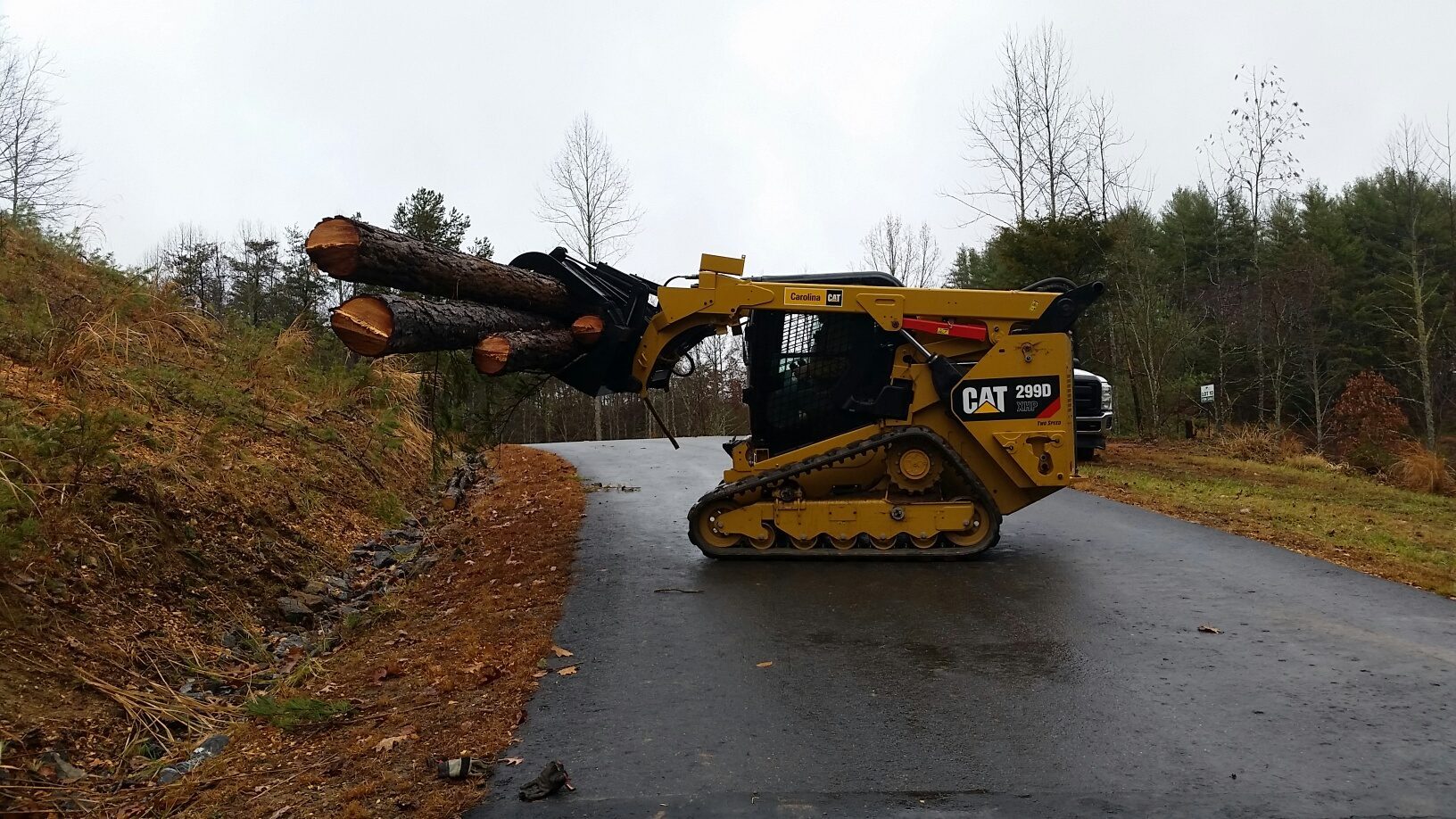
The grapple bucket attachment mounted to our 299D CAT xhp devised to lift trees, rocks, logs, brush, culverts and more up to 4500 lbs.
other cleared lots will help explain your vision.)
- Do you have valuable timber on your property and do you need to contact a lumber broker for resale?
- What happens with the trees, debris and large stone after clearing? Is it hauled away, piled out of site or burned?
- What about drainage on the site? Do you have any or anticipate any potential drainage issues?
- Are there zoning, HOA covenants, restrictions or permits required before the job can start?
- What areas do you want to be cleared and preserved?
- Are there view scapes to consider and how will they be cut out?
We are equipped to handle the production of lot and land clearing with our machinery for this type of work. Our equipment includes a 299D CATxhp mulcher with clearing head on skid steer loader, a Woodsman 18x Chipper with winch and drag loader equipped with a rolling wheel, a grapple bucket attachment to lift and maneuver weighty, awkward size materials, a Kubota track hoe with thumb and Kubota BX-24 tractor with backhoe. You are guaranteed a fast, efficient thorough job leaving your property clear, clean and void of mess and debris ready to build, plant or develop.
If you’re ready to discuss your property needs with a professional, call our office at 828-712-1590 or contact us online to schedule a consultation.
Lawn-N-Order Landscaping, Inc.
PO Box 1551
Weaverville, NC 28787
